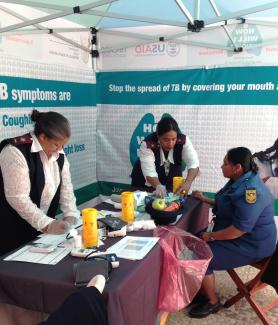USAID's health program in South Africa is one of the Agency's largest and a focus of the U.S. Global Health Initiative, and USAID’s work focuses on leadership, governance and capacity building of the South African health system for greater sustainability. In addition, USAID is working to strengthen South Africa’s health system overall by improving policy, logistics and monitoring and evaluation.
South Africa is the center of the global AIDS epidemic, home to an estimated 5.6 million people living with the disease. Through the President’s Emergency Plan for AIDS Relief, USAID works with the public and private sectors, nongovernmental organizations and faith-based partners to train and support workers serving those with HIV and AIDS.
- USAID has enabled the provision of antiretroviral treatments to over 1.4 million and ensured that more than two million HIV-infected people received care and support services.
- USAID supports the South African National TB Program in building the diagnostic and treatment capacity needed to help curb the public health threat created by the HIV and AIDS-related tuberculosis epidemic and a growing incidence of drug-resistant tuberculosis.
PEPFAR is making the transition from its initial emergency response to sustainability, with an emphasis on prevention over the next five years. This next phase of PEPFAR will support countries in reassessing prevention portfolios to ensure that they are targeted for maximum impact. The program is working to identify, implement and evaluate promising and innovative prevention methods, to expand PEPFAR's existing toolkit of interventions, and to advance the science around HIV prevention.
Tuberculosis
Despite making tremendous strides in creating a unified public health system, South Africa has the third-highest burden of tuberculosis worldwide. Health care delivery at the local level remains a challenge, and historical inequities persist. In line with the priorities of the Government of South Africa, USAID’s TB programs strengthen primary health care systems and integrate HIV and TB care to better identify and manage those who are co-infected with these diseases.

USAID/Southern Africa DOC
